How Much and How Often to Water Venus Flytrap
-
Pete Ortiz
- Last updated:
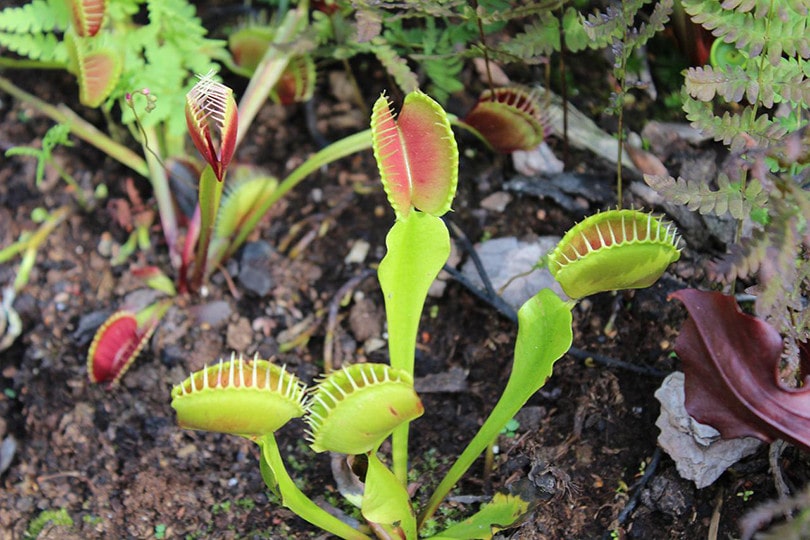
Venus flytraps are interesting carnivorous plants that can be found in subtropical wetlands in the United States, particularly in Florida and the Carolinas. Venus flytraps have a rather dramatic way of getting their daily nutrients, to which they owe their popular name.
These plants stand about 4 to 6 inches high and have a round, spiked trapping structure at their top that lures unsuspecting insects that land on top of it. Once they do, the spiked structure snaps shut, trapping the insect and then slowing digestion it over a few hours. Dramatic? So that is how this plant eats in the wild. They also get all of their water from rainfall and from the moist environment in which they live.
But how do you water it as a houseplant? We’ll explain this and other care tips for Venus flytraps in this article.
How to Water Venus Flytraps
Venus flytraps can be watered using regular tap water and it’s best to water them every 2 to 4 days, depending on the season. During the spring and summer months, you will typically need to water the plant every few days. However, during the winter dormancy months, watering the plant two or three times a month is normal.
The amount of water will depend on the size of your plant and the time to come up but you should pour enough water until it reaches about a half an inch above the topsoil. The soil should be kept on the moist side, but you should never allow it to become waterlogged as this can cause root rot and other issues.
It should stay well-draining and slightly moist–just like that of their native environment. When watering the plant, be sure to pour the water directly around the base so that it can penetrate the roots beneath the plant.
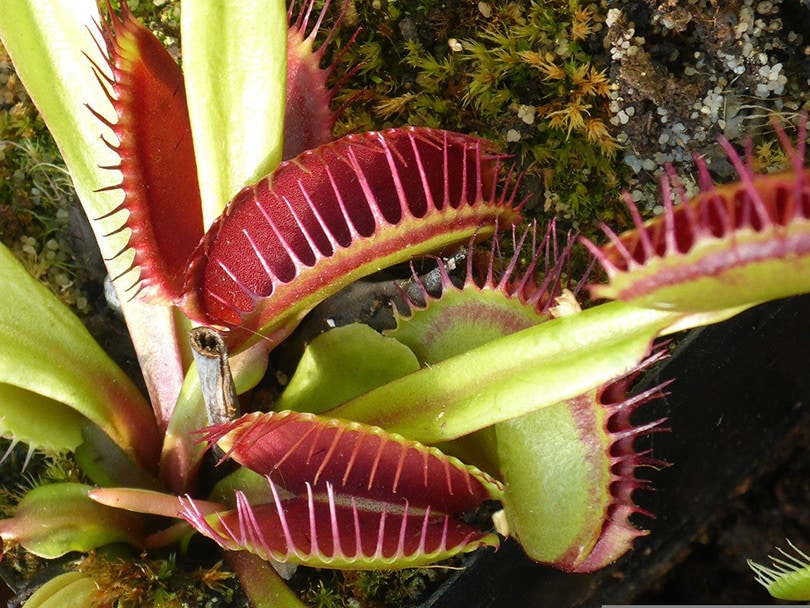
How to Know If You’re Underwatering or Overwatering
Like any other houseplant, Venus flytraps can be damaged by overwatering or underwatering. For example, overwatering the plant can cause waterlogging and root rot, while underwatering can lead to stunted growth and a dry, brittle plant that may not survive the next few weeks. If the soil has been kept too dry, you might see brown spots under the leaves.
Overwatering can also cause the leaves to soon become wilted as the plant won’t be able to draw enough water into the stem. The stems of plants will become weaker, and the leaves’ tips may turn yellowish green in color. This is a sign that the plant is trying to conserve energy by shutting off photosynthesis.
This also means the plant will not be growing new tissue, which means stunted growth. For this reason, it’s important to check the plant daily to ensure that it’s healthy and isn’t showing signs of distress.
Watering During Winter
Watering requirements will be different for the plant in the winter as it enters its dormant growth stage. During this stage, houseplants typically conserve more water, which means less watering is needed.
These plants, like other plants, also cease to produce flowers and fruits during dormancy. When your Venus flytrap starts to bloom again after being dormant, you will know that spring is just around the corner. This is usually around mid-March to early April.
During winter dormancy, you will usually only need to water it 2 to 3 times per month. You can monitor the soil’s moisture level to determine how often it needs watering, depending on where you live. To do this, simply stick your index finger in the soil to about an inch beneath the top surface. The soil should feel moist and not too dry and crumbly. If it is dry, be sure to give it a good watering session.
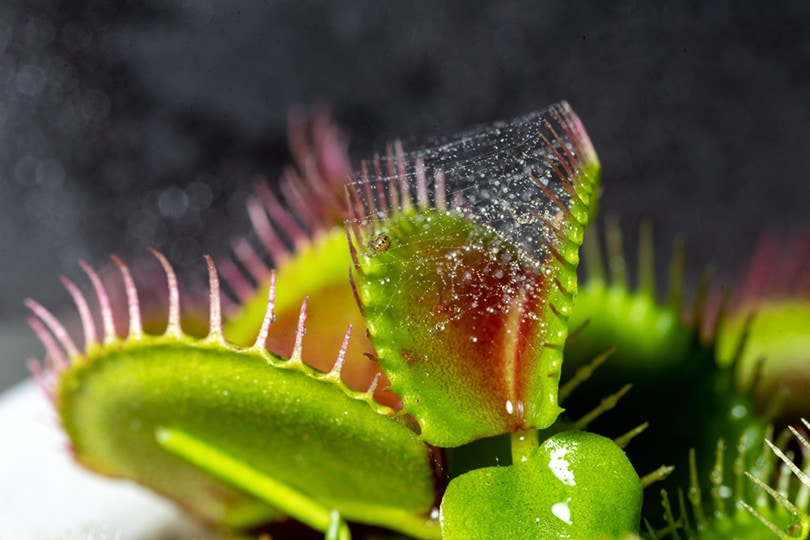
Feeding Your Venus Flytrap
Venus flytraps eat flies and other small insects as their main food source. Prey must be alive at the time of capture, as this allows them to absorb all of the much-needed nutrients from the insect. To be effective insects must be placed directly inside the trap to cause it to close and start digesting the food. And to keep bacteria out, the insect must be small enough for the trap to form an effective seal around it.
Flytraps are carnivorous but can survive for a long time (up to 20-30 days) without eating at all. They can be grown outdoors and will eat enough food to sustain themselves – all without human intervention. However, you will need to feed the insects regularly if you grow a Venus Flytrap indoors.
Note that you shouldn’t give your flytrap any insects larger than one-third of its size, as the trap won’t be able to close completely. Live flies can be difficult to feed because of their speed, but smaller spiders, mealworms, caterpillars, and beetles will work just fine.
How Often and How Much to Feed My Venus Flytrap?
Your flytrap can be grown outdoors and will likely eat enough food to sustain it. A simple rule of thumb for indoor growers is to only feed one trap each week. It takes a lot of energy to close a trap, and then digest the prey.
The plant will be temporarily weakened if it is fed too many traps in a short time. Overfeeding your plant can cause it to produce smaller traps that will eventually lead to it recovering. It’s easy to picture how tired and lazy I feel after eating a large meal.
Each trap can be used for up to three meals before it eventually dies. It takes traps around ten days for prey to be digested and they remain closed the whole time.
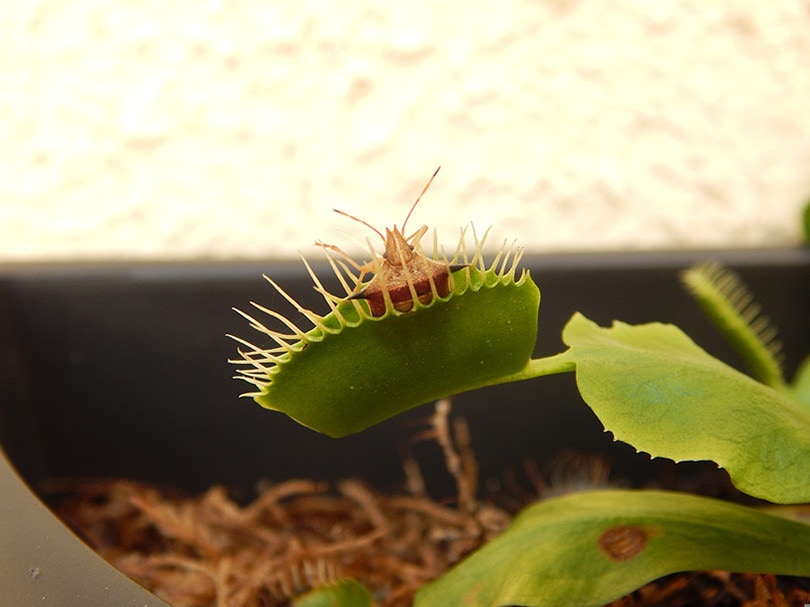
How Much Light for Venus Flytrap?
Venus flytraps require lots of daily sunshine to thrive. If you’re growing one indoors then place it on the sunniest windowsill. It will grow strong leaves if it gets hours of sunlight every day. If not, the leaves will wilt and fall off at some point. Not enough windows in your home? Well, you can also set up artificial grow lights for the plant.
Temperature & Humidity Requirements
Venus fly traps thrive in warmer weather conditions. Temperatures between 70 and 95 degrees Fahrenheit are ideal in the spring and summer months. And during the winter months, temperatures can get as low as 48° Fahrenheit and this plant will still survive. Venus flytraps love humidity and thrive in subtropical conditions. However, they can also survive outside.
This makes them easy to control in conservatories and greenhouses. Note that these fly traps will lose their leaves and turn black during winter dormancy, but this doesn’t mean that they are dead. Simply remove any dead leaves and re-pot the flytrap in March if it’s outgrown its old pot.
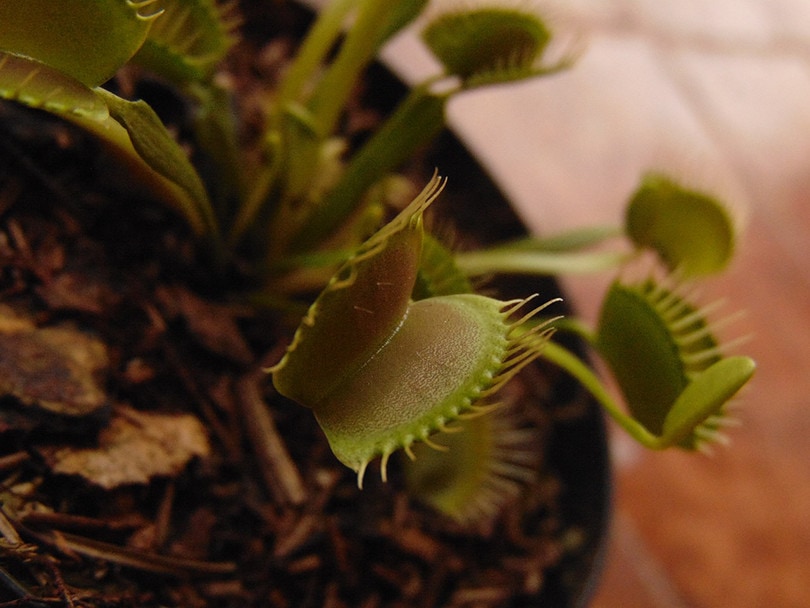
Soil Requirements for Venus Flytrap
Venus flytraps should be planted in an acidic soil mixture made from sphagnum moss. This can be purchased at any local horticulture supply or gardening store. You typically don’t need to fertilize the soil unless the plant is recovering from illness.
How to Re-pot Your Venus Flytrap
It is best to re-pot your plant at least once per year in order to keep it growing and thriving. This allows the soil to stay fresh and gives the roots more room to grow. Try to re-pot it in the spring and summer as opposed to the colder months, but don’t do this while the plant is still flowering.
To accommodate the root system, choose a pot at least 3-4 inches in depth. The pot should allow about 2 inches between the roots and the sides for insulation.
Make sure to prepare a pot using the correct soil mixture. Also, add water from rainwater or filtered water. To loosen the topsoil, gently squeeze the sides of your pot after pouring in the mixture.
When handling the plant, be sure to gently the root ball and shake off any excess dirt before putting it in the soil. Next, water the flytrap thoroughly, and then use your fingers to press the soil around the roots.
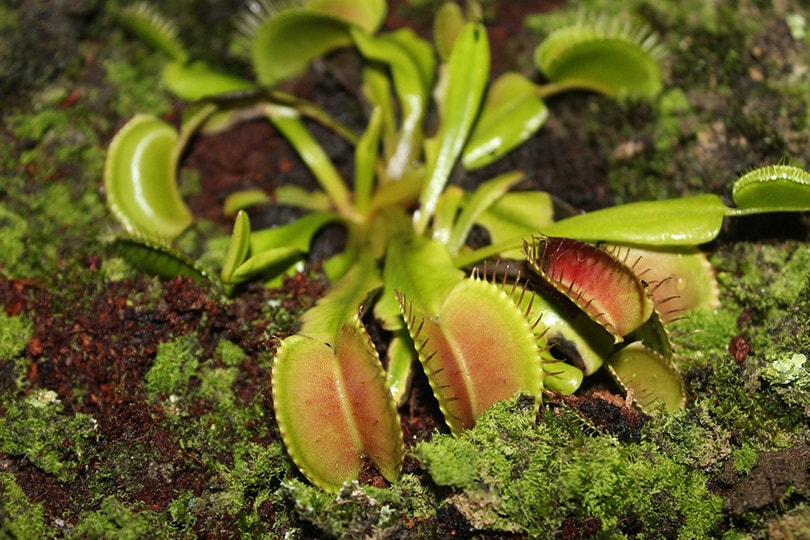
Are Venus Flytraps a Threatened Plant Species?
Yes. The endangered species status was granted to the Venus flytrap in 2005. So, it’s best not to remove a Venus flytrap if you should happen to come across the plant outdoors. The change in their original habitat is due to increased agricultural development and large-scale urbanization.
Poachers have also reduced the number of these popular wild plants. Poachers take the flytraps out of their habitats and then sell them to make a profit. You can buy a Venus Flytrap for about $5-$7 online or at your local plant nursery.
Conclusion
Venus Flytraps make for intriguing houseplants, and they don’t take much to maintain. You do, however, want to ensure that your plant is adequately hydrated, and this means watering it every 2 to 4 days in the warmer months and about two to three times during the winter dormancy. Hopefully with this information and other care tips, you can help your Venus flytrap thrive.
See also:
Featured Image Credit: tityan, Pixabay
Contents


